
54 Years Ago: ‘Our Man Flint’ Helps Invent the James Bond Parody
On Jan. 16, 1966, less than a month after the release of the fourth James Bond film, Thunderball, Our Man Flint, premiered. The movie starred James Coburn as the unstoppable and impossibly knowledgeable Agent Derek Flint.
It did well at the box office, and spawned a 1967 sequel as well as a Canadian television show, but its most important contribution to movie culture was to bring into the mainstream the hallowed tradition of the James Bond parody film.
These had been produced in Europe since nearly the beginning of the Bond series, but the idea hadn't really taken hold in the U.S. yet. Our Man Flint changed all that.
It elevated Coburn from supporting roles into a leading man, turned a profit for a major studio (20th Century Fox) and proved that parody films – both James Bond and otherwise – could be successful in the New Hollywood of the late '60s and '70s.
Watch 'Our Man Flint' Trailer
Just like in the Bond films, Our Man Flint tells the story of a secret agent who gets a hazardous mission, journeys to a foreign land in search of clues about evildoers and finds himself embroiled in an action-packed final confrontation with evil in a high-tech, stylized bad-guy lair. But it's also a comedy, a send-up of everything that makes the movies starring the unflappable 007 so beloved.
A threat to the future of the civilized world? Check! Derek Flint has to stop an evil cabal of scientists that's figured out how to control the climate by boring into the center of the Earth (no, it doesn't make any sense at all) and threatening to turn the planet into a dystopic hippy commune.
A sexy female love interest? Check! Derek Flint is attended by not one but four gorgeous women who clothe and shave him, and has to do battle with another woman (Gila Golan) who's initially an adversary but is won over by Derek Flint's suavity.
An improbable competence at all things martial and cultural? Check! Derek Flint can do kung fu, identify the specific ingredients of a Bouillabaisse made in Marseilles, restart a man's heart by plugging his finger into a light socket and touching the man's chest and induce a state of suspended animation in which his own heart appears to have stopped, conveniently fooling his adversaries into thinking he's dead.
A fight with an agent from a real Bond film? Almost! While he's in Marseilles, Derek Flint engages in mock fisticuffs with one Triple-O-Eight, hurling him around a bar while exchanging information about their respective missions.
Watch a Scene From 'Our Man Flint'
On top of all this, Our Man Flint also manages the trick of being a pretty entertaining adventure film in its own right. Coburn is superbly cast as the lead. He has the kind of debonair but slightly edgy charisma that one needs to be a super-spy, and plays the comedy with a pitch-perfect, wry confusion as to why anyone would possibly doubt his immense capacities.
He also does surprisingly well in his fight scenes, coming off as far more nimble and athletic than either Sean Connery or Roger Moore.
The movie also pulls off a number of clever set pieces. These include a sequence in which Flint breaks into a walk-in safe only to find himself trapped inside and the safe actually a trailer the bad guys can use to transport him across the Italian countryside.
Later, viewers are taken to the island headquarters of the evil group (called Galaxy), where a continual groovy party is taking place and women are being turned into submissive sex slaves.
Watch a Scene From 'Our Man Flint'
Flint introduced a surprising number of elements into pop culture. The ringtone indicating that the leader of Derek Flint's organization Z.O.W.I.E. is receiving a call from the president of the United States was used in the 1991 Bruce Willis movie Hudson Hawk and also shows up in the Mike Myers Bond parody Austin Powers: International Man of Mystery. The name of one of the bad guys in the film, Hans Gruber, was used as the name of the main bad guy in 1988's Die Hard. And jazz flautist Herbie Mann covered the title theme (by noted composer Jerry Goldsmith) on his 1966 album Our Man Flute, as did a number of other bands in the late '60s.
But its place in the tradition of parody films is Our Man Flint's true legacy. Its closest American predecessors are the six Universal Pictures Abbott and Costello monster movies, starting with Abbott and Costello Meet Frankenstein from 1948 and extending through Abbott and Costello Meet the Mummy in 1955.
After these, the parody tradition in America lost momentum; Flint brought it roaring back to life again. Columbia put out its own comedy Bond movie, Casino Royale in 1967. Mel Brooks' career started in the same year with The Producers, and by 1974 he had made Blazing Saddles and Young Frankenstein, both immensely profitable genre parodies. In 1975 there was The Rocky Horror Picture Show, 1976 would bring Murder by Death and by the time the Zucker Brothers released Airplane! in 1980, there was no turning back. The parody film was fully ensconced in American cinematic life, and has remained so for four decades.
The contemporary satirical tradition is astoundingly varied. It's full of high and low comedy, good movies and TV shows ... as well as terrible ones. And by this point, there are more Bond parodies than it's worth listing. But Our Man Flint remains one of the best, and most influential, of them all.
James Bond Movies Ranked
More From 92.9 The Lake









